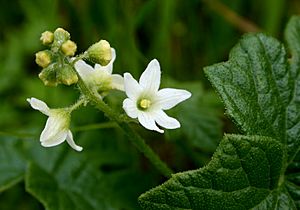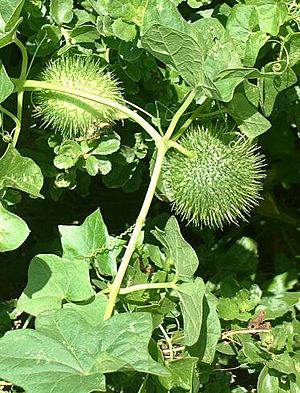Marah fabacea facts for kids
Quick facts for kids Marah fabacea |
|
|---|---|
 |
|
| Scientific classification | |
| Genus: |
Marah
|
| Species: |
fabacea
|
The Marah fabacea, also known as the California manroot, bigroot, or sometimes space pods, is a very common plant found in California. It's one of several "manroot" species that grow in the state. You can find it in almost all the same places where other California manroots grow. Sometimes, different types of manroots even mix and create new kinds of plants!
Contents
What is California Manroot?
California manroot is a unique plant with thick, hairy stems and special parts called tendrils. These tendrils help the plant grab onto things and climb. The vines start to grow in late winter when it rains more. They can climb or spread out up to 6 meters (about 20 feet) long!
How it Grows: Stems, Leaves, and Roots
The leaves of the California manroot usually have five main parts, like fingers on a hand. But, different plants can have leaves of many sizes and shapes.
The Amazing Tuber
These long vines grow from a huge, hard root called a tuber. This tuber can be several meters long and weigh more than 100 kilograms (over 220 pounds)! That's like a giant potato! You might see these big roots along roadsides or on hillsides where the soil has worn away. They look scaly and tan. If a tuber gets hurt or starts to decay, it can turn a golden or orange color.
Flowers and How They Reproduce
The flowers of the California manroot can be yellowish-green, cream, or white. They start to appear soon after the vines begin to grow. This plant has both male and female flowers on the same plant. The male flowers grow in open groups, while the female flowers usually grow by themselves and have a swollen base.
The plant can fertilize itself! This means pollen from the male flowers can reach the female flowers on the same plant. Pollination is done by insects, which help carry the pollen.
The Fruit and Its Seeds
The fruit of the California manroot is round, about 4 to 5 centimeters (1.5 to 2 inches) across. It's covered in prickly spikes that can be up to 1 centimeter long, but they don't have hooks. When the fruit is young, it's bright green. As it gets older, it turns yellow. The fruit swells up as it ripens, and then it finally bursts open, letting out its large seeds. Fruits start to form in spring and are ready by early summer. It's important to know that the fruit is not safe to eat.
How Seeds Sprout
The seeds of the California manroot are big, hard, and very smooth. Each fruit usually holds four or more seeds. These seeds start to sprout in the cool, wet weather of late winter. They have a very interesting way of growing! The first part of the plant that comes out of the seed grows downwards into the ground. Then, this shoot splits into two parts. One part starts to swell up and become the big tuber, while the other part grows back up to the surface and becomes the vine you see.
Where California Manroot Lives
The California manroot grows best near streams or in wet areas. But it can also do well in dry chaparral areas, up to 1600 meters (about 5,200 feet) high. You can find it in most parts of California, except for the very far northwest and the Mojave Desert. It can grow in many different types of soil and acidity levels, but it needs soil that is wet at certain times of the year.
The vines can grow in full sunlight or in partly shaded spots. In places where it stays mild and wet all year, the vines can live for many years. But in areas like California with a Mediterranean climate (wet winters, dry summers), the manroot vines grow after the winter rains, live until late spring, and then completely die back in the hot, dry summer.
Interesting Uses of the Plant
Long ago, the Kumeyaay people would crush the tubers of the California manroot and throw them into streams. This would make the fish unable to move, so they could be caught easily. The tubers contain natural chemicals called saponins. Saponins make water bubbly, like soap. These chemicals would get into the fish's bodies through their gills, making them float to the surface.
All parts of the plant have a bitter taste. The name Marah even comes from a Hebrew word meaning "bitter." Even though it's bitter, the leaves have sometimes been used as a vegetable. Because of its saponin content, the large tuber of the manroot can be processed to make a soap-like liquid. The liquid inside the fruit can irritate your eyes, and the spikes on the fruit can irritate your skin.


